Coins Around The World
Coins are valuable historical artefacts that can illuminate the economics, technology, art, politics, religion and ceremonies of a generation. How a nation chooses to represent itself on its coinage is testimony to what it values and celebrates.
The coins produced by The Royal Mint can offer important insights into the history of not only the United Kingdom but also most other countries of the world.
The Natural World
Mozambique
After achieving independence from Portugal, Mozambique’s first independent coinage was struck by The Royal Mint in 1975.
The new coins, based on the metica of 100 centimos, consisted of eight denominations. All show the portrait of President Samora Machel on the obverse, while the reverses are principally floral in theme.
Mozambique has since become a republic and The Mint in 1994 struck republican coins for a reformed currency of 100 centavos to the metical. They consisted of 1 metical and 5, 10 and 20 meticais in brass-plated steel and 50, 100, 500 and 1000 meticais in nickel-plated steel. All show on the obverse the arms of the republic, while the variety of images on the reverse include buildings, a lobster, a leopard’s head, a kingfisher and, on the 1 metical, a seated female student.
In 1998 The Mint struck a coin of 5000 meticais, which combines the arms of the republic with electric pylons. More recently coins have been struck for a new system in which the revalued metical consists of 100 centavos. Shown here is a 50 centavos of 2012, which combines the kingfisher with the emblem of the Bank of Mozambique.
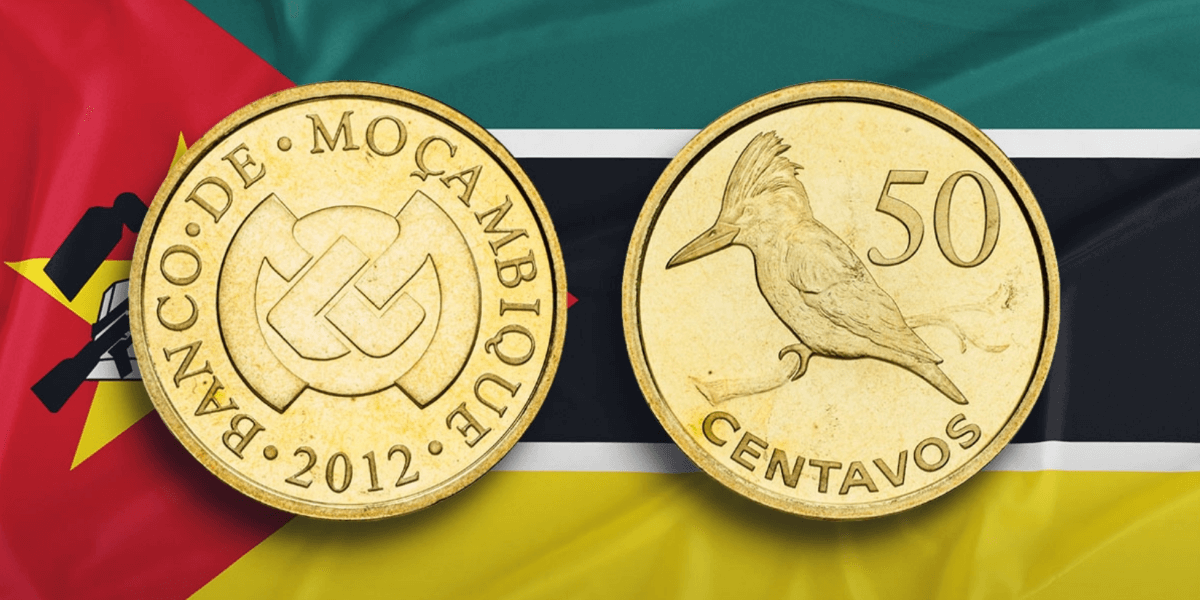
Mozambique fifty centavos
Papua New Guinea
From 1910 the newly-introduced Australian coins circulated in British New Guinea, but between 1929 and 1945 these Australian coins were supplemented by special ½d, 1d, 3d, 6d and 1 shilling coins.
These coins were struck by the Melbourne branch of The Royal Mint but the master tools necessary for their production were prepared by The Royal Mint at Tower Hill. They are remarkable for all having a central hole, making them easy to carry on strings but preventing the use of a royal portrait.
For numismatists they are also unusual in including a penny with the royal cypher of Edward VIII. Because there was no need to wait for a portrait, the coins were completed and issued before the abdication of the king. They are therefore part of a small group of overseas coins struck in the name of Edward VIII and as such are of particular interest to collectors.
When British New Guinea achieved independence in 1975 as Papua New Guinea an entirely new coinage based on the kina of 100 toea was produced by The Royal Mint. The word kina is to be found in pidgin language as the name of a valuable pearl shell, while the toea or arm-shell had a traditional use in coastal Papua for trading and bride-price payments. The Bird of Paradise appears on the obverse of the coins, while the reverses appropriately include a butterfly, a turtle, a butterfly fish, a cuscus monkey and a cassawari bird.
The 1 kina coin deliberately recalls the earlier coins of British New Guinea in having a central hole. Its obverse shows a stylised bird and the reverse two alligators, as seen here on a recent 1 kina of 2009.
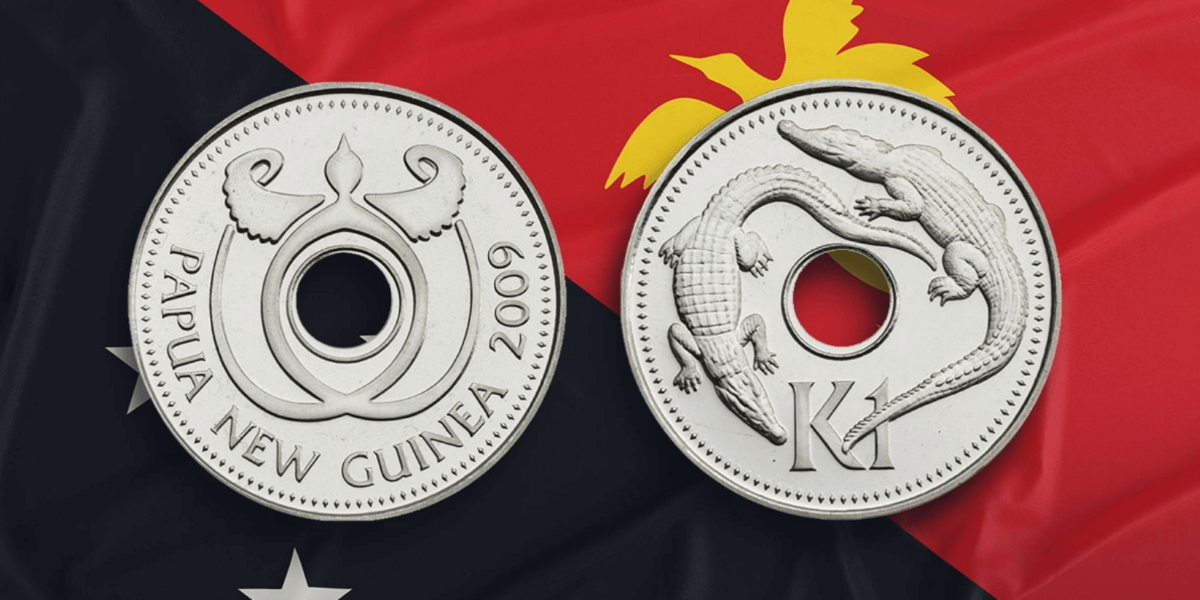
Papua New Guinea one kina
Australia
The Royal Mint has had a long association with the coinage of Australia, dating back to the early years of the nineteenth century when British coins were first sent out to circulate among the early colonists.
The discovery of gold in the middle years of the century prompted the opening of branches of The Royal Mint in Australia, first at Sydney in 1855, then at Melbourne in 1872 and finally at Perth in 1899. These branch mints struck sovereigns and half-sovereigns that enjoyed a world-wide circulation alongside the sovereigns and half-sovereigns struck by The Royal Mint in London.
In 1910 Australia adopted a distinctive coinage of its own to replace British coins. These coins were at first struck in the United Kingdom but during the First World War production was taken over by the branch mints. Though The Royal Mint continued to assist with the preparation of master tools, no more coins were struck until 1951, when for a time the Australian mints, despite working at full capacity, could not keep pace with demand.
When Australia changed over to a decimal coinage of dollars and cents in 1966, The Royal Mint was again involved in the production of master tools and coins to assist the newly-opened Royal Australian Mint in Canberra. The decimal coins feature an attractive series of wildlife designs by Stuart Devlin, among them a duck-billed platypus on this twenty-cent piece.
More recently, in the early 1980s, The Royal Mint was again able to offer assistance by producing coins at a time when the supply of coins by the Royal Australian Mint was temporarily interrupted.
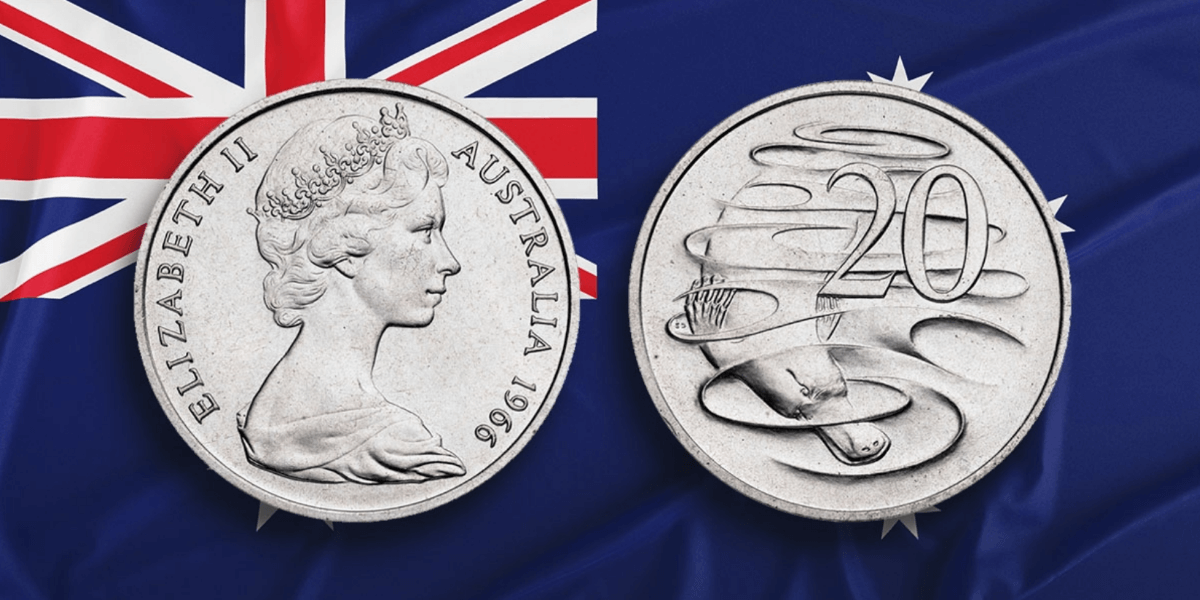
Australia twenty cents
St Helena and Ascension
British coins provided the day-to-day currency needs of the islands, but from the 1970s commemorative coins were struck for both St Helena and Ascension, beginning with a crown piece in 1973 to celebrate the tercentenary of the Royal Charter granting the East India Company the right to occupy and govern St Helena.
In 1984 The Royal Mint assisted with the preparation and striking of an entirely new series of coins for St Helena and Ascension. Following United Kingdom coins in shape, size and value, the coins show on the obverse the portrait of Queen Elizabeth II and on the reverses a series of designs by the British artist Mike Hibbit featuring wildlife familiar on the islands.
Thus a yellow fin tuna is to be found on the 1p, a donkey on the 2p, a wirebird on the 5p, an arum lily-the national emblem of St Helena – on the 10p, the famous green turtle of Ascension Island on the 50p, and the sooty tern or wideawake on the pound.
Shown here is a 50p piece of 1991, which mirrors the seven-sided shape of the corresponding United Kingdom coin.
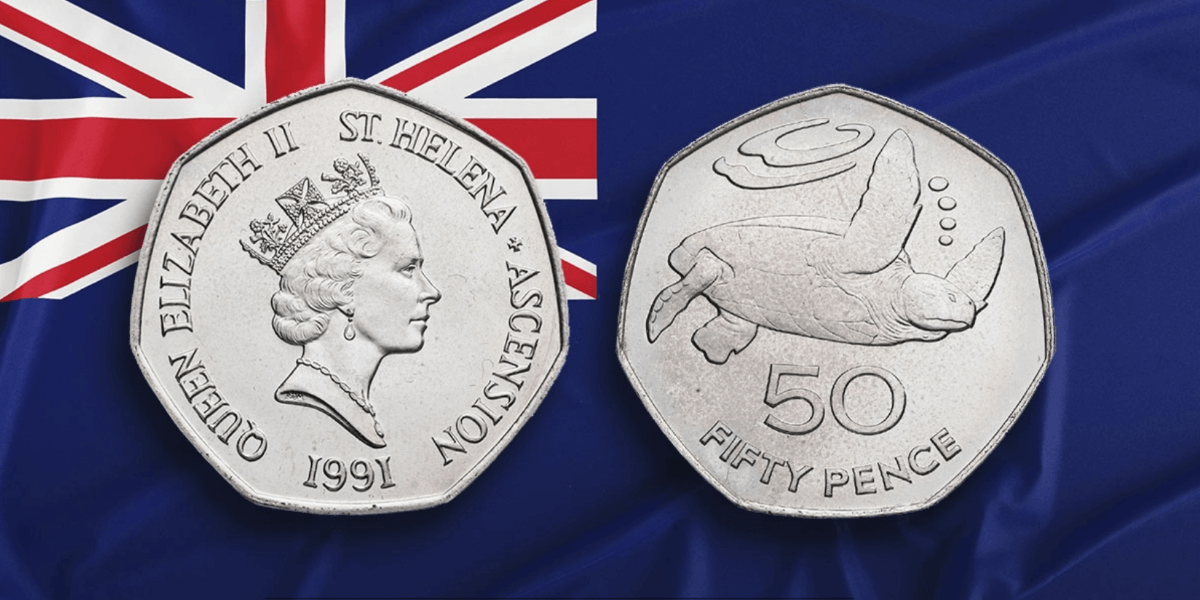
St Helena and Ascension fifty pence
Landmarks
Turkmenistan
The Royal Mint first struck coins for Turkmenistan in 1993, shortly after its independence from the Soviet Union.
Based on a manat of 100 tenge, the three lower value coins of 1, 5 and 10 tenge are copper-plated steel and the 20 and 50 tenge are nickel-plated steel. All five denominations show the profile portrait of President Saparmurat Niyazov and his portrait also appears on the higher value 500 and 1000 manat struck in 1999.
Following the death of the President in 2006, coins of new design were struck in 2009. On these coins the portrait of the late President was replaced by a design showing the Independence Monument in Ashgabat superimposed on a map of Turkmenistan.
In 2010 higher value coins of 1 and 2 manat were added to the currency, bi-metallic in construction and similar in design to the lower value coins of 2009. Shown here is the 1 manat of 2010.
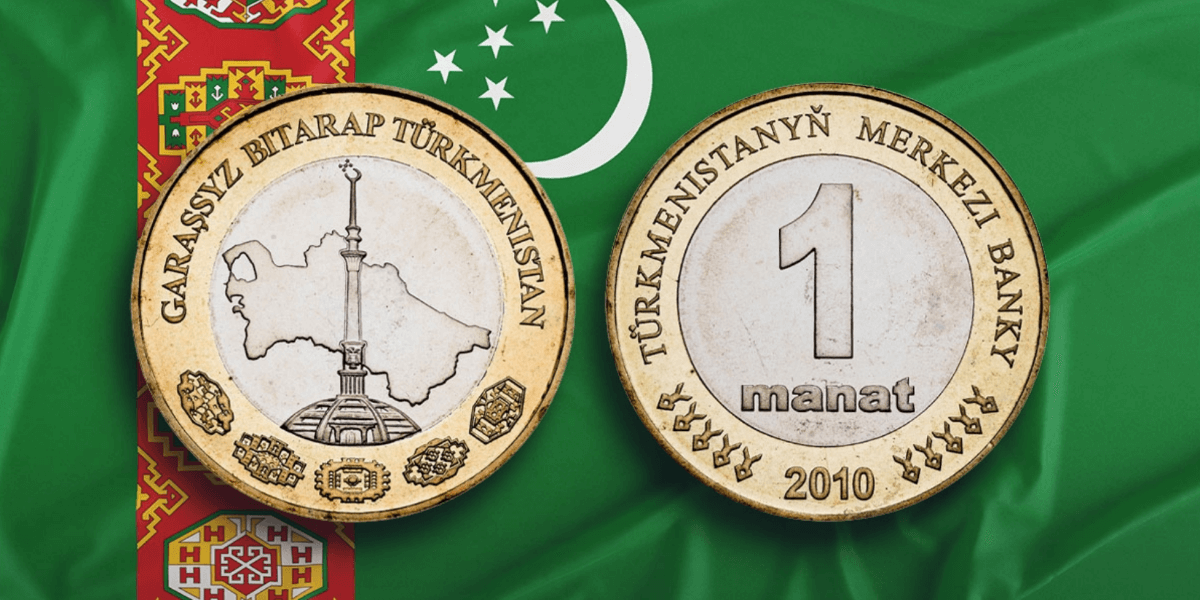
Turkmenistan one manat
Malaysia
When The Royal Mint struck the first coins for independent Malaysia in 1967, our relationship with the region already stretched back over 150 years.
It had begun in 1810, when coins were struck for the East India Company to circulate in Prince of Wales’s Island, now part of modern Penang. Made of copper, they were in fact the first coins to be struck at the new Royal Mint on Tower Hill.
The relationship continued from the early 1870s with production of coins for the Straits Settlements, in denominations of cents and dollars, that circulated throughout Malaya. In 1939 a Currency Board was established to issue coins in the name of Malaya and then from 1953 in the name of Malaya and British Borneo.
In 1967 the new coins of Malaysia, now denominated in terms of a ringgit or dollar of 100 sen, were of the same shape and size as those already in circulation.
Their designs, however, show on the obverse a representation of Parliament House in Kuala Lumpur, while on the reverse the denominational value is prominently displayed, accompanied by a stylised version of the national flower, the hibiscus.
Because of the urgency with which the coins were required, some of them were despatched by air to Malaysia. This is a faster form of transport but because coins in bulk are very heavy they are normally sent by sea.
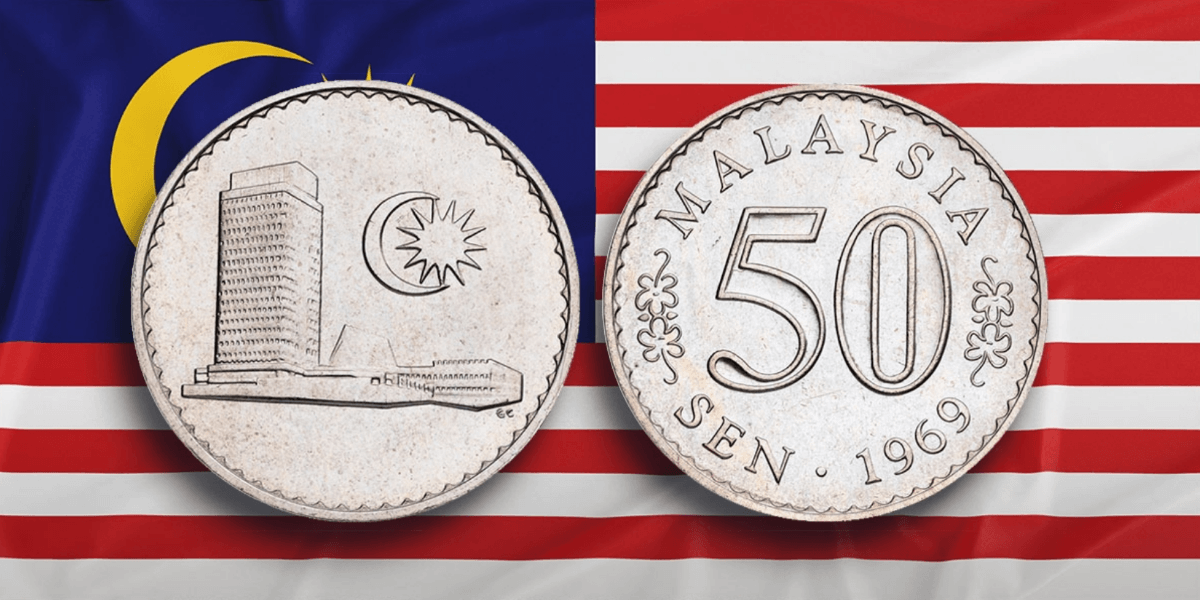
Malaysia fifty sen
Iraq
Iraqi coins were first struck by The Royal Mint in 1931. Made in bronze, nickel and silver and based on a riyal of 200 fils, they show the portrait of King Faisal I by the British sculptor Percy Metcalfe.
This marked the start of a regular and continuing relationship. In due course the coins of King Faisal I were superseded by coins of King Ghazi I, whose portrait was also the work of Metcalfe, and then by coins of King Faisal II, who was crowned in 1953. For his portrait on the coins of that year the schoolboy King gave a sitting to the artist Humphrey Paget in his tiny room at Harrow.
After the revolution The Mint struck coins for the new republic in 1959, with the royal portrait replaced by a representation of the arms of Iraq. From 1967 this gave way to a design showing three palm trees on irrigated land with a palm grove in the background. This design also served for the 250 fils of 1970, struck as part of an international programme to promote the work of the Food and Agriculture Organisation of the United Nations.
By 1982 the coinage consisted of 5 and 10 fils with a scalloped or wavy edge, round 20 and 50 fils, an eight-sided 250 fils, a square 500 fils and a ten-sided 1 dinar. This full range of coins was struck in that year with designs inspired by the restoration of the city of Babylon.
The 1 dinar of 1982, shown here, features the Tower of Babylon.
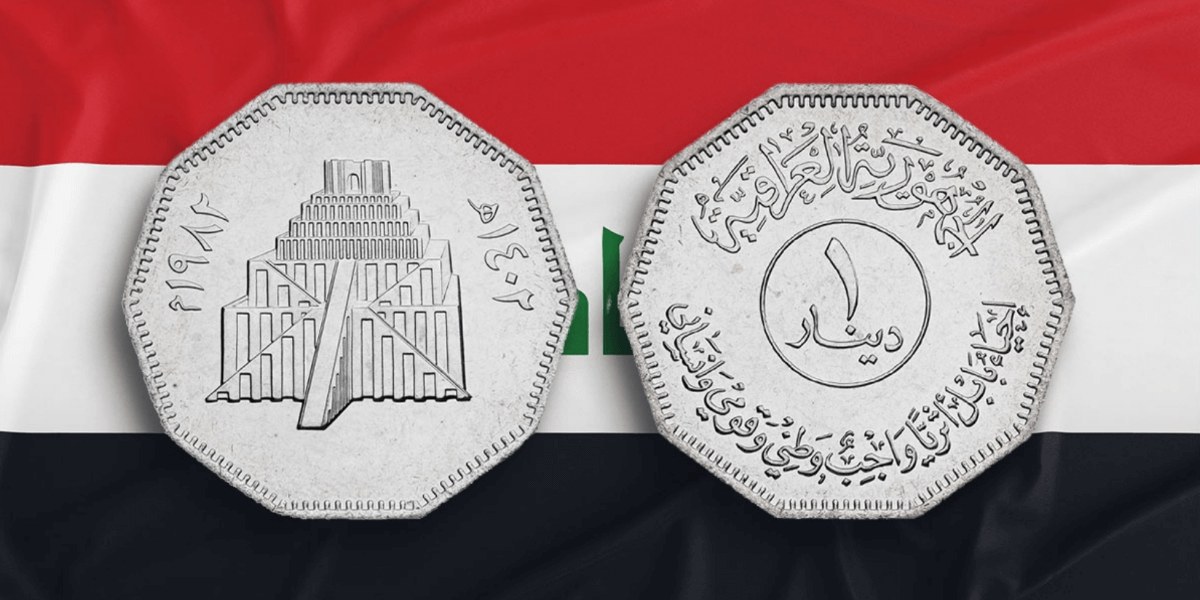
Iraq one dinar
National Heroes
Jamaica
From the 1820s British coins circulated in Jamaica, among them threepenny pieces and specially-struck three-halfpence coins in silver.
British copper and bronze coins proved unpopular in the island, so unpopular that distinctive pennies and halfpennies in a new white-coloured alloy, cupro-nickel, were introduced in 1869. This was the first time that The Royal Mint had struck coins in cupro-nickel and the new pennies and halfpennies were well enough received for a cupro-nickel farthing to be added in 1880. These coins, their composition eventually changed to nickel-brass, continued to circulate alongside British coins well into the twentieth century and even for a few years after independence in 1962.
The first coins of independent Jamaica, based on a dollar of 100 cents, were struck by The Royal Mint in 1969. They feature the Coat of Arms of Jamaica that had appeared on the earlier pennies, halfpennies and farthings and on the reverse a series of designs by Christopher Ironside based on local fauna and flora, including a ‘Doctor Bird’ and a crocodile.
Shown here is a one dollar coin of 2014, which combines the usual Coat of Arms with a portrait of Sir Alexander Bustamante, the first Prime Minister of Jamaica and a national hero.
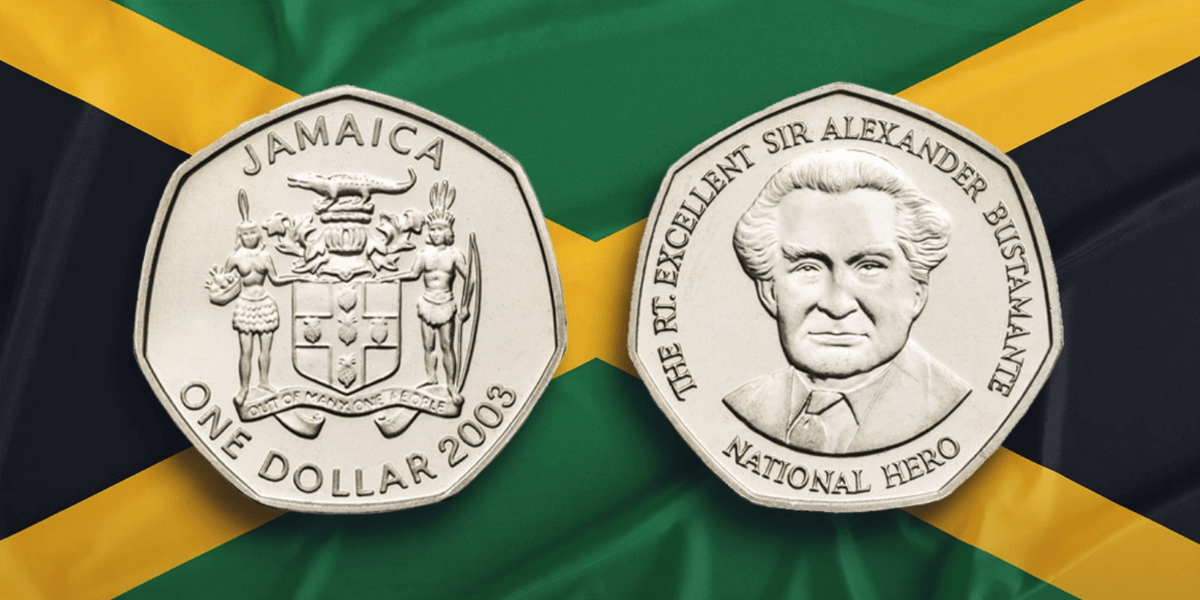
Jamaica one dollar
Malta
From 1827 until 1913 The Royal Mint struck small coins, one third of a farthing in value, for circulation in Malta. These coins bore no territorial designation and at first were regarded by The Royal Mint as part of the British imperial coinage.
Normal British coins also circulated in Malta and it was not until 1972 that the island introduced a distinctive coinage of its own. Prepared by The Royal Mint, the new coinage was an unusual range of round and shaped coins in cupro-nickel, bronze and aluminium. The designs, which represent aspects of the island’s history, were the work of the celebrated British artist Christopher Ironside, who had recently achieved numismatic distinction with his reverse designs for the new decimal coinage of the United Kingdom.
Shown here is the bronze one cent piece, with its representation of the George Cross famously awarded by George VI in acknowledgement of the fortitude and gallantry of the people of the island during the Second World War.
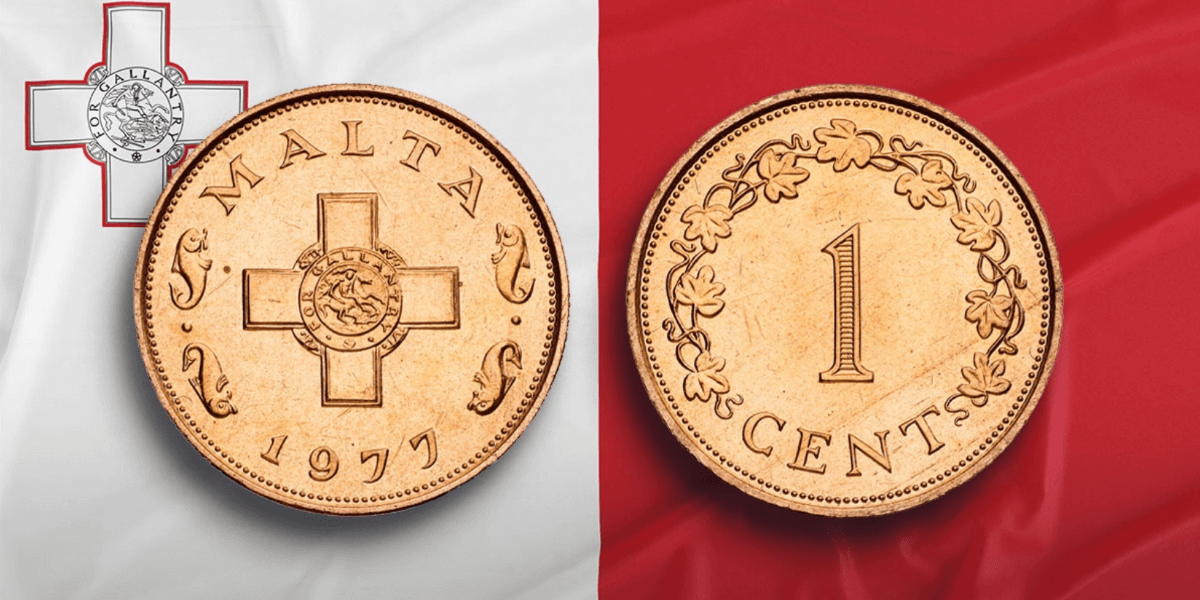
Malta one cent
The Philippines
The Royal Mint first struck coins for the Philippines in 1964. These coins would normally have been struck by the United States Mint but at that time the US Mint was fully stretched by the demand for American coins.
This first order was for a total of 275 million coins in four denominations. The coins were of existing designs and we made new dies from samples of coins in circulation in the Philippines. They show on the obverse the Seal of the Republic and, on the reverse, a female figure at an anvil with an erupting volcano in the background.
The following year special commemorative one peso coins were struck in silver to honour the national heroes Andres Bonifacio and Apolinario Mabini. Their portraits were modelled for the coinage by the British sculptor Michael Rizzello.
Another large order followed in 1975 for 5 sentimo pieces in brass and 1 sentimo pieces in aluminium, the former having a scalloped or wavy edge and the latter being square. Both feature a man turning a large wheel with a ship unloading cargo in the background, with the native chief Lapulapu on the 1 sentimo and, shown here, the revolutionary hero Melchora Aguino on the 5 sentimos.
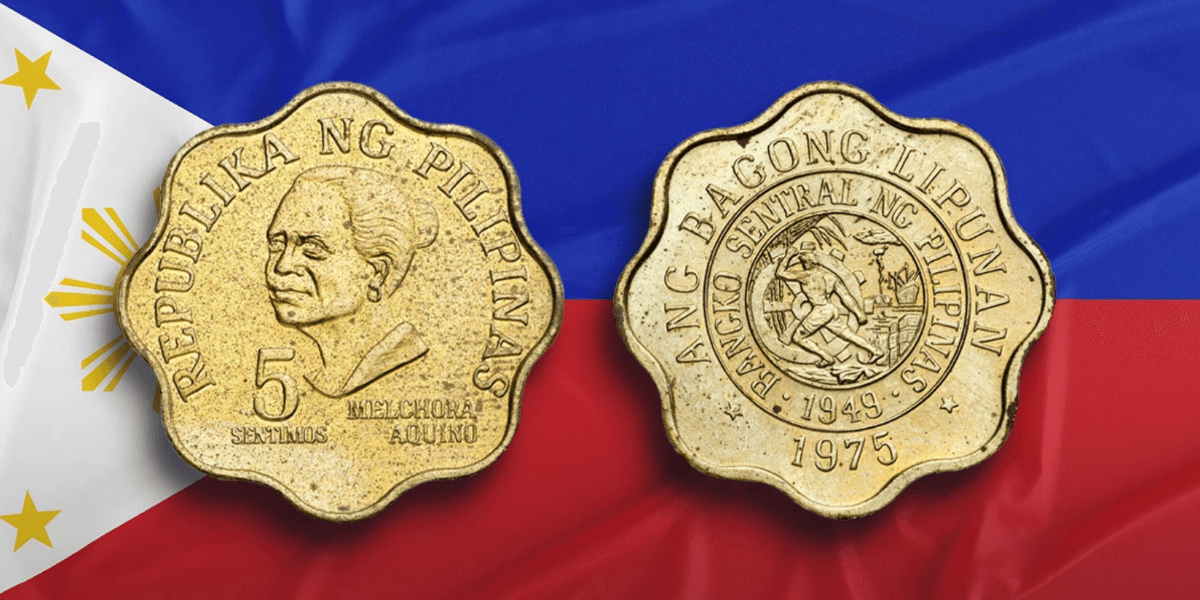
Philippines five sentimos
Nigeria
The Royal Mint’s involvement with Nigeria dates back to the nineteenth century, when increasingly large quantities of British silver coins were being shipped out to West Africa.
Early in the twentieth century the West African Currency Board took over responsibility for the supply of coinage and its familiar coins, many of them struck by The Royal Mint, circulated in Nigeria until the approach of independence in 1960.
In 1959 The Royal Mint helped Nigeria to prepare its first distinctive coinage, receiving a massive order for something like 1000 million coins. These coins, based on the British system of pounds, shillings and pence, consisted of six denominations ranging from the bronze halfpenny to the cupro-nickel florin. With their designs featuring ground nuts, palm-tree foliage, cocoa-pods and cotton flowers, the coins would have had immediate meaning for the people of Nigeria.
This first coinage of independent Nigeria was superseded in 1973 by a new decimal system based on a naira of 100 kobo. The royal portrait was replaced by the Nigerian coat of arms and the reverses, while still obviously local in their themes, give more prominence to the denominational value.
Nigeria now has a mint of its own, but The Royal Mint has on occasion provided assistance in the form of coins, blanks and dies. Shown here is a 1 naira piece of 1981 with its portrait of Herbert Macaulay, the famous Nigerian nationalist, who was also an engineer, an architect, a journalist and a musician.
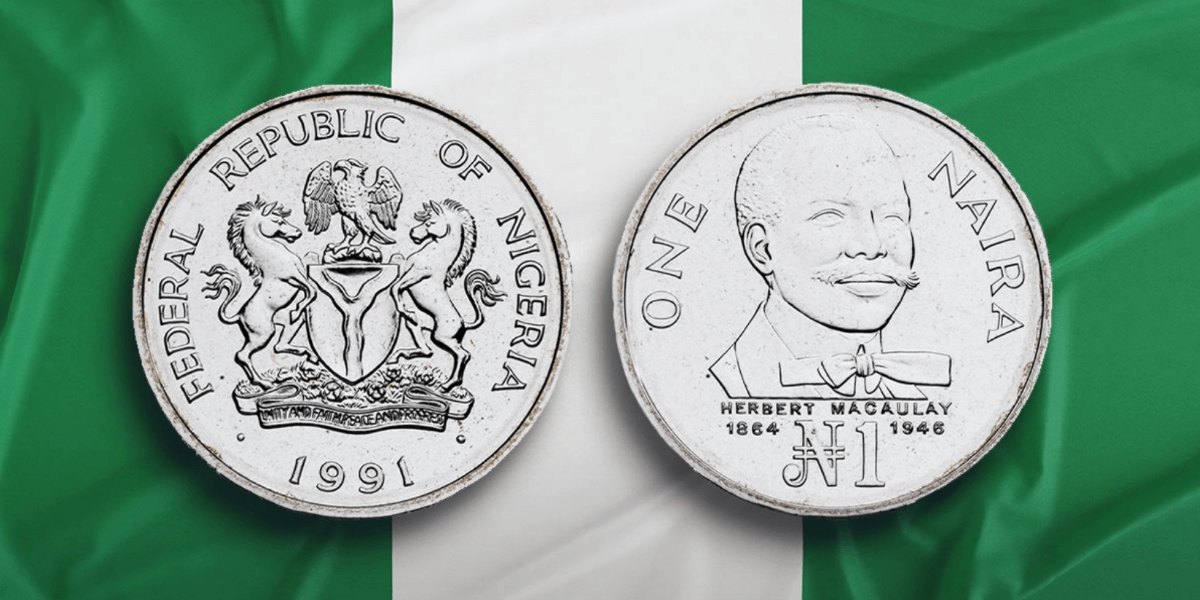
Nigeria one naira
Ships
Cape Verde
Although The Royal Mint had been involved in the issue of coins to celebrate the World Fisheries Conference in 1984 and the visit in 1990 of Pope John Paul II, the first circulating coins were not struck for Cape Verde until 1994.
They consisted of six denominations from the 1 escudo to the 100 escudos. The lower-value coins were made of plated steel, but the 100 escudos was bi-metallic in construction and ten-sided in shape. All show the national emblem on the obverse, while the reverses are a mixture of ships, birds and flowers.
For all denominations, apart from the small 1 escudo with its tartaruga sea turtle, more than one reverse design was used. On the 20 escudos, there were three designs: the alcatraz or brown booby, the medicinal carqueja flower and, shown here, the Novas de Alegria.
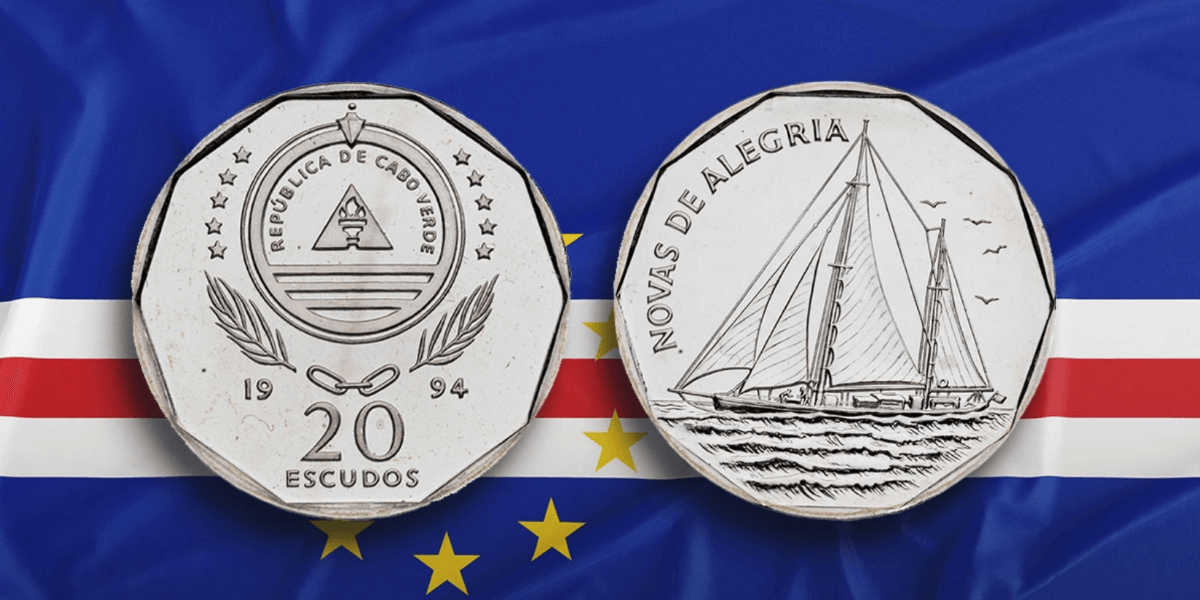
Cape Verde twenty escudos
East Caribbean States
From early in the nineteenth century British coins had been shipped to the Caribbean, but when in the 1950s certain of the Caribbean territories agreed to form a currency federation a new decimal coinage was introduced based on the local dollar of 100 cents.
On their obverse the coins show a crowned portrait of Queen Elizabeth II by Cecil Thomas. The reverses were modelled by another British artist, Humphrey Paget, and feature crossed branches of palm, the Golden Hind of Sir Francis Drake, and the combined arms of the federal territories.
Because of political changes, the designation of the coinage was changed in 1981 from the British Caribbean Territories to East Caribbean States. The 1 cent and 5 cents now became scalloped or wavy-edged coins in aluminium and the 2 cents a square coin, again in aluminium. Branches of palm and Drake’s Golden Hind continued to feature on the reverse but the obverse was up-dated to show Arnold Machin’s portrait of the Queen.
This 1 dollar of 2004 now shows the later portrait of the Queen Elizabeth II by Ian Rank-Broadley.
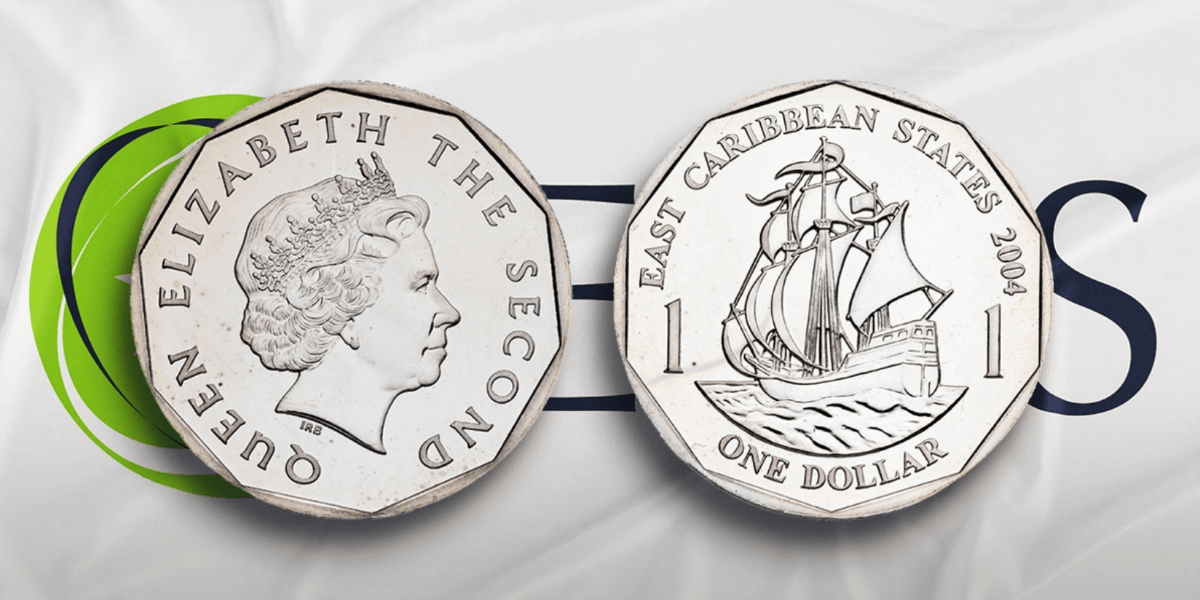
East Caribbean States one dollar
Kuwait
Coins for Kuwait were first struck by The Royal Mint in 1960, when an entirely new series of coins was prepared based on a dinar of 1000 fils.
There were initially six denominations from the 1 fils to the 100 fils, the lower value coins in nickel-brass and those of higher value in cupro-nickel. All show on the obverse an Arab dhow, a sailing vessel familiar in the Arabian Sea and reproduced by hand for the new coinage by a Royal Mint engraver from a drawing supplied by Kuwait.
Since then the coins, virtually unchanged, have continued to be struck by The Royal Mint. Production was, however, temporarily interrupted by the Iraqi invasion of 1990, when The Royal Mint was actually in the process of delivering an order for Kuwaiti coins and completion had to await the restoration of the Kuwaiti government.
Shown here is a 100 fils piece of 2007, still in cupro-nickel and still closely resembling the original coin of 1960.
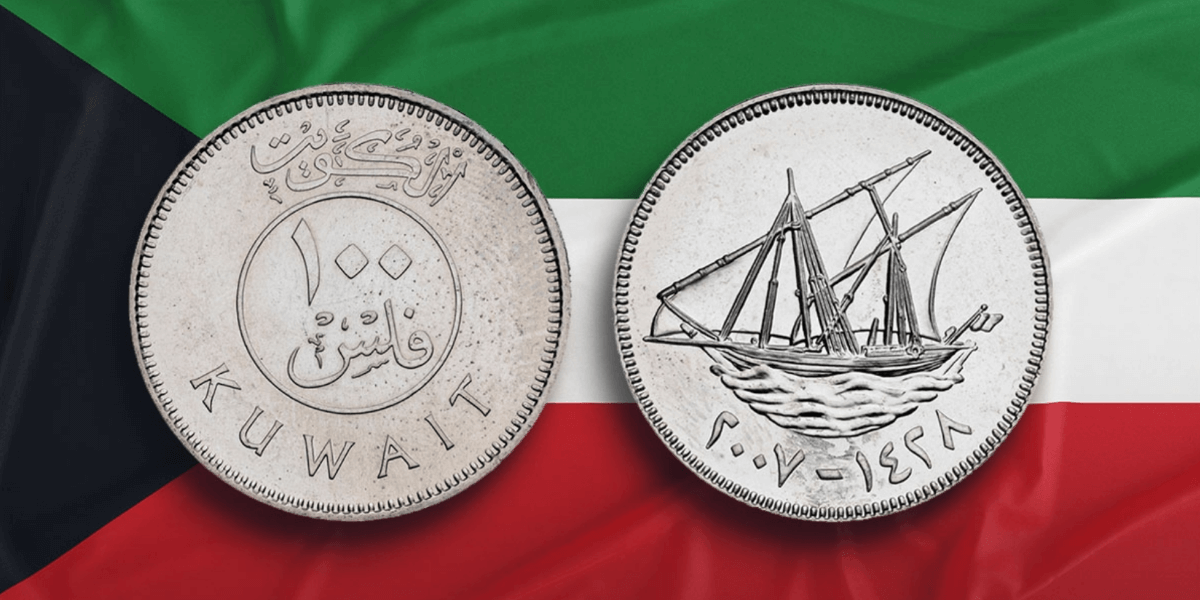
Kuwait 100 fils
Fiji
In 1934 difficulties caused by the concurrent circulation of British and Australian coins prompted Fiji to introduce a coinage of its own.
The coinage followed the British system of pounds, shillings and pence. Sixpences, shillings and florins in silver showed the crowned portrait of George V, with a turtle on the sixpence, a canoe on the shilling and a shield of arms on the florin.
Rather more unusual were the new pennies and halfpennies, which were struck with a central hole to enable them to be conveniently carried on strings. They were also made of cupro-nickel, and not as might have been expected of bronze, since the local inhabitants were said to dislike the colour and taste of bronze.
A twelve-sided threepence, showing a native hut or bure, was added in 1947. However, a much larger change came in 1969 when, with the continuing assistance of The Royal Mint, the Fijian coinage was decimalised on the basis of a dollar of 100 cents.
The new coins continued to show the royal portrait but now displayed an attractive series of reverse designs, featuring a ceremonial whale’s tooth, a throwing club, a Fijian drum, a fan and a communal mixing and serving bowl.
Other coins have since been struck for Fiji and shown here is a twelve-sided 50 cent piece of 2006 featuring a small sailing vessel similar to that on the original shilling of 1934.
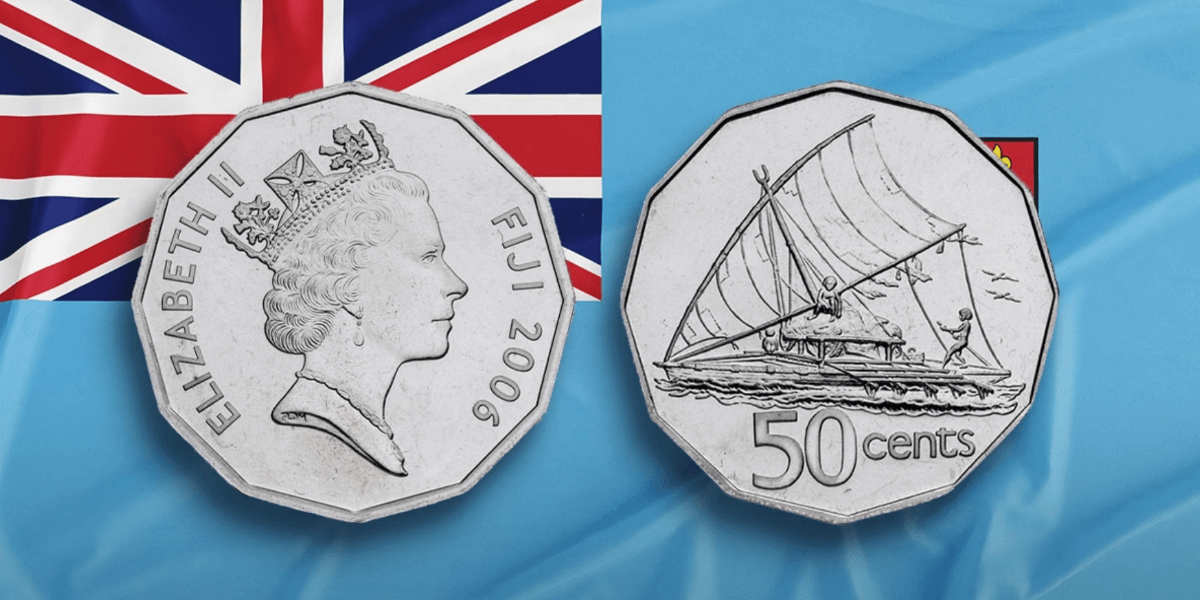
Fiji fifty cents
Myths and Legends
Cyprus
In 1878 Britain became responsible for the administration of Cyprus and The Royal Mint immediately sent out a supply of British coins to the island.
The following year ¼, ½ and 1 piastre coins in bronze were introduced and in 1901 there were added 3, 4 1/2, 9 and 18 piastre coins in silver, there being nine piastres to the shilling. Coins of these denominations continued to be struck until after the Second World War, though by then the ¼ piastre had been abandoned and the ½ and 1 piastre coins had become smaller coins with a scalloped or wavy edge.
In 1955 a new decimal coinage was struck by The Royal Mint, retaining the pound as the basic unit of currency but now sub-divided into 1000 mils. The coins were more pictorial in design, showing a fish to represent the sea, an ingot bearer for the mining industry, a bull’s head for agriculture, a symbolic tree to represent forests, and a ship for trade.
Soon afterwards Cyprus became a republic and in 1963 coins were issued which replaced the portrait of the Queen with the emblem of the Republic. A 1 mil coin in aluminium took the place of the 3 mils coin and the ship design was transferred to the 5 mils. The other designs were superseded by ears of wheat, a cedar cone, a bunch of grapes and a mouflon or wild sheep.
In 1983 a currency system of 100 cents to the pound saw the introduction of new coins in aluminium and nickel-brass. For their obverse they retained the emblem of the Republic, but the reverses now show a pied wheatear, a modern vase, an old silver bowl, two goats, a stylised bird, and a cyclamen. A 50 cent coin was added to the coinage in 1985 and, shown here, is the cupro-nickel 50 cent coin of 1991, now seven-sided in shape and showing Europa and the bull.
Since 2008 Cyprus has had a euro coinage but these coins have not been struck by The Royal Mint.
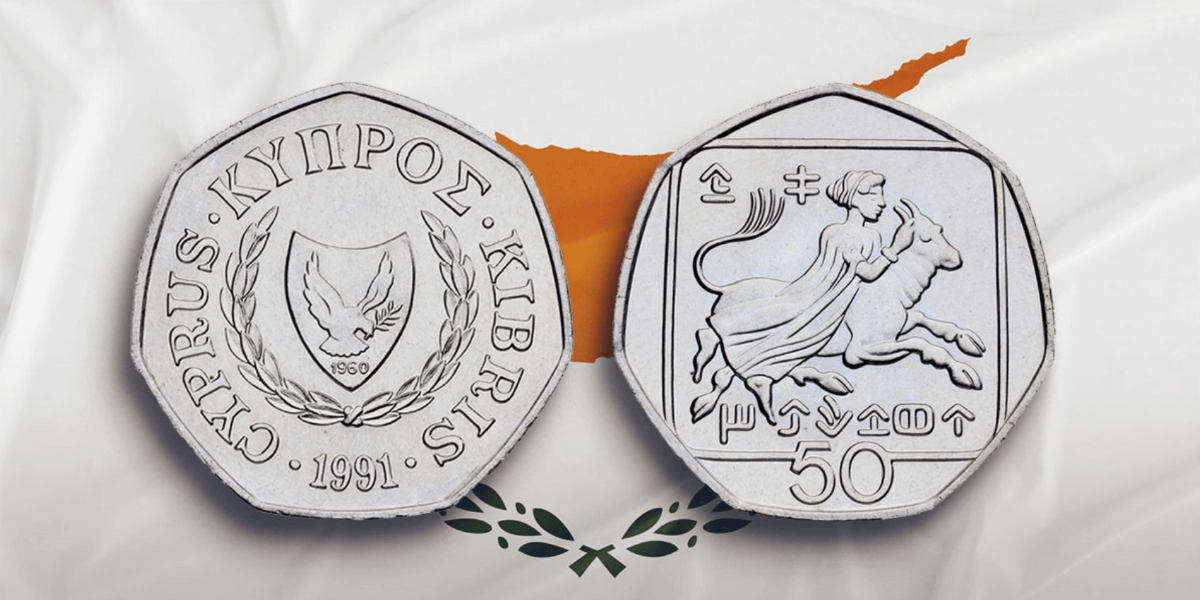
Cyprus fifty cents
Iceland
Iceland first came to The Royal Mint for its coinage requirements during the darkest days of the Second World War, after the occupation of Denmark had deprived it of the services of the mint in Copenhagen.
The existing coins, which showed the Icelandic coat of arms and the cypher of the king of Denmark, were skilfully copied by The Royal Mint. But we took care to omit the small letters and symbols peculiar to the Copenhagen mint.
Production began on Friday 22 November 1940 in conditions that must have seemed strangely appropriate.
‘Striking began at day-break after a night during which the windows and roofs had been wrecked by enemy action; a glacial wind whirled round the coining presses to inaugurate this coinage of Iceland.’
It marked the start of a long and happy relationship and Iceland remained a customer of The Royal Mint for more than 70 years. Highlights include the striking of a handsome series of gold and silver commemorative coins in 1974 to mark the 1100th anniversary of the settlement of Iceland and then in 1981 the development of an entirely new range of circulating coins.
This 100 kronur coin of 1995 features on the obverse the guardian spirits – a bull, a bird, a dragon and a giant – that protect the island, with a north Atlantic lumpfish on the reverse.
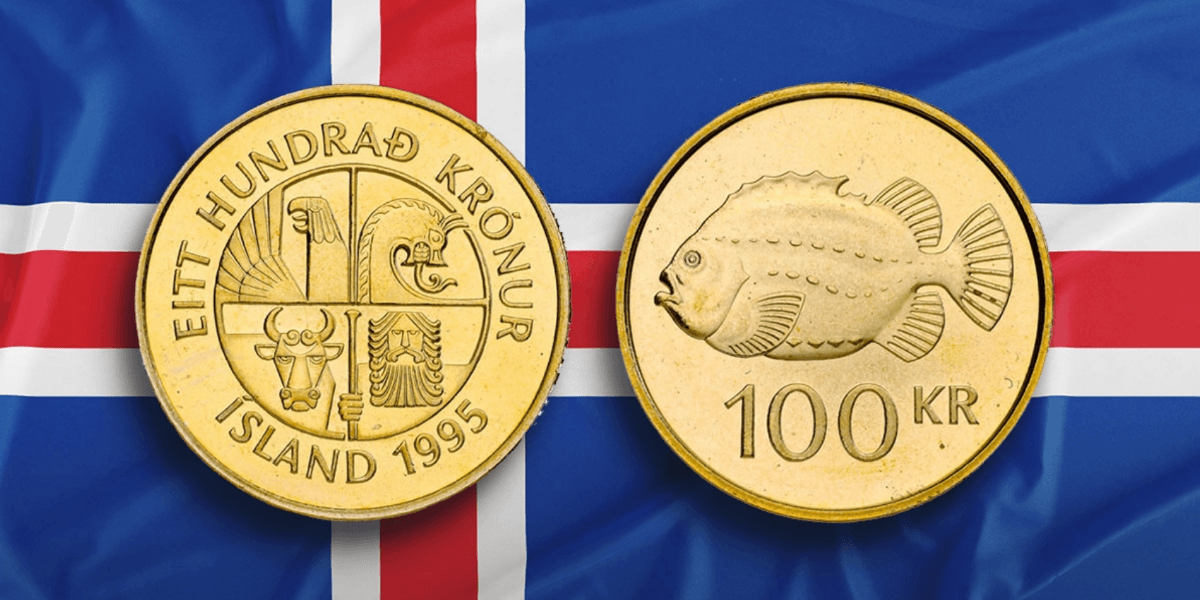
Iceland 100 kronur
Content provided, with thanks, by The Royal Mint Museum.
Coins Around The World
Coins are valuable historical artefacts that can illuminate the economics, technology, art, politics, religion and ceremonies of a generation. How a nation chooses to represent itself on its coinage is testimony to what it values and celebrates.
The coins produced by The Royal Mint can offer important insights into the history of not only the United Kingdom but also most other countries of the world.
The Natural World
Mozambique
After achieving independence from Portugal, Mozambique’s first independent coinage was struck by The Royal Mint in 1975.
The new coins, based on the metica of 100 centimos, consisted of eight denominations. All show the portrait of President Samora Machel on the obverse, while the reverses are principally floral in theme.
Mozambique has since become a republic and The Mint in 1994 struck republican coins for a reformed currency of 100 centavos to the metical. They consisted of 1 metical and 5, 10 and 20 meticais in brass-plated steel and 50, 100, 500 and 1000 meticais in nickel-plated steel. All show on the obverse the arms of the republic, while the variety of images on the reverse include buildings, a lobster, a leopard’s head, a kingfisher and, on the 1 metical, a seated female student.
In 1998 The Mint struck a coin of 5000 meticais, which combines the arms of the republic with electric pylons. More recently coins have been struck for a new system in which the revalued metical consists of 100 centavos. Shown here is a 50 centavos of 2012, which combines the kingfisher with the emblem of the Bank of Mozambique.

Mozambique fifty centavos
Papua New Guinea
From 1910 the newly-introduced Australian coins circulated in British New Guinea, but between 1929 and 1945 these Australian coins were supplemented by special ½d, 1d, 3d, 6d and 1 shilling coins.
These coins were struck by the Melbourne branch of The Royal Mint but the master tools necessary for their production were prepared by The Royal Mint at Tower Hill. They are remarkable for all having a central hole, making them easy to carry on strings but preventing the use of a royal portrait.
For numismatists they are also unusual in including a penny with the royal cypher of Edward VIII. Because there was no need to wait for a portrait, the coins were completed and issued before the abdication of the king. They are therefore part of a small group of overseas coins struck in the name of Edward VIII and as such are of particular interest to collectors.
When British New Guinea achieved independence in 1975 as Papua New Guinea an entirely new coinage based on the kina of 100 toea was produced by The Royal Mint. The word kina is to be found in pidgin language as the name of a valuable pearl shell, while the toea or arm-shell had a traditional use in coastal Papua for trading and bride-price payments. The Bird of Paradise appears on the obverse of the coins, while the reverses appropriately include a butterfly, a turtle, a butterfly fish, a cuscus monkey and a cassawari bird.
The 1 kina coin deliberately recalls the earlier coins of British New Guinea in having a central hole. Its obverse shows a stylised bird and the reverse two alligators, as seen here on a recent 1 kina of 2009.

Papua New Guinea one kina
Australia
The Royal Mint has had a long association with the coinage of Australia, dating back to the early years of the nineteenth century when British coins were first sent out to circulate among the early colonists.
The discovery of gold in the middle years of the century prompted the opening of branches of The Royal Mint in Australia, first at Sydney in 1855, then at Melbourne in 1872 and finally at Perth in 1899. These branch mints struck sovereigns and half-sovereigns that enjoyed a world-wide circulation alongside the sovereigns and half-sovereigns struck by The Royal Mint in London.
In 1910 Australia adopted a distinctive coinage of its own to replace British coins. These coins were at first struck in the United Kingdom but during the First World War production was taken over by the branch mints. Though The Royal Mint continued to assist with the preparation of master tools, no more coins were struck until 1951, when for a time the Australian mints, despite working at full capacity, could not keep pace with demand.
When Australia changed over to a decimal coinage of dollars and cents in 1966, The Royal Mint was again involved in the production of master tools and coins to assist the newly-opened Royal Australian Mint in Canberra. The decimal coins feature an attractive series of wildlife designs by Stuart Devlin, among them a duck-billed platypus on this twenty-cent piece.
More recently, in the early 1980s, The Royal Mint was again able to offer assistance by producing coins at a time when the supply of coins by the Royal Australian Mint was temporarily interrupted.

Australia twenty cents
St Helena and Ascension
British coins provided the day-to-day currency needs of the islands, but from the 1970s commemorative coins were struck for both St Helena and Ascension, beginning with a crown piece in 1973 to celebrate the tercentenary of the Royal Charter granting the East India Company the right to occupy and govern St Helena.
In 1984 The Royal Mint assisted with the preparation and striking of an entirely new series of coins for St Helena and Ascension. Following United Kingdom coins in shape, size and value, the coins show on the obverse the portrait of Queen Elizabeth II and on the reverses a series of designs by the British artist Mike Hibbit featuring wildlife familiar on the islands.
Thus a yellow fin tuna is to be found on the 1p, a donkey on the 2p, a wirebird on the 5p, an arum lily-the national emblem of St Helena – on the 10p, the famous green turtle of Ascension Island on the 50p, and the sooty tern or wideawake on the pound.
Shown here is a 50p piece of 1991, which mirrors the seven-sided shape of the corresponding United Kingdom coin.

St Helena and Ascension fifty pence
Landmarks
Turkmenistan
The Royal Mint first struck coins for Turkmenistan in 1993, shortly after its independence from the Soviet Union.
Based on a manat of 100 tenge, the three lower value coins of 1, 5 and 10 tenge are copper-plated steel and the 20 and 50 tenge are nickel-plated steel. All five denominations show the profile portrait of President Saparmurat Niyazov and his portrait also appears on the higher value 500 and 1000 manat struck in 1999.
Following the death of the President in 2006, coins of new design were struck in 2009. On these coins the portrait of the late President was replaced by a design showing the Independence Monument in Ashgabat superimposed on a map of Turkmenistan.
In 2010 higher value coins of 1 and 2 manat were added to the currency, bi-metallic in construction and similar in design to the lower value coins of 2009. Shown here is the 1 manat of 2010.

Turkmenistan one manat
Malaysia
When The Royal Mint struck the first coins for independent Malaysia in 1967, our relationship with the region already stretched back over 150 years.
It had begun in 1810, when coins were struck for the East India Company to circulate in Prince of Wales’s Island, now part of modern Penang. Made of copper, they were in fact the first coins to be struck at the new Royal Mint on Tower Hill.
The relationship continued from the early 1870s with production of coins for the Straits Settlements, in denominations of cents and dollars, that circulated throughout Malaya. In 1939 a Currency Board was established to issue coins in the name of Malaya and then from 1953 in the name of Malaya and British Borneo.
In 1967 the new coins of Malaysia, now denominated in terms of a ringgit or dollar of 100 sen, were of the same shape and size as those already in circulation.
Their designs, however, show on the obverse a representation of Parliament House in Kuala Lumpur, while on the reverse the denominational value is prominently displayed, accompanied by a stylised version of the national flower, the hibiscus.
Because of the urgency with which the coins were required, some of them were despatched by air to Malaysia. This is a faster form of transport but because coins in bulk are very heavy they are normally sent by sea.

Malaysia fifty sen
Iraq
Iraqi coins were first struck by The Royal Mint in 1931. Made in bronze, nickel and silver and based on a riyal of 200 fils, they show the portrait of King Faisal I by the British sculptor Percy Metcalfe.
This marked the start of a regular and continuing relationship. In due course the coins of King Faisal I were superseded by coins of King Ghazi I, whose portrait was also the work of Metcalfe, and then by coins of King Faisal II, who was crowned in 1953. For his portrait on the coins of that year the schoolboy King gave a sitting to the artist Humphrey Paget in his tiny room at Harrow.
After the revolution The Mint struck coins for the new republic in 1959, with the royal portrait replaced by a representation of the arms of Iraq. From 1967 this gave way to a design showing three palm trees on irrigated land with a palm grove in the background. This design also served for the 250 fils of 1970, struck as part of an international programme to promote the work of the Food and Agriculture Organisation of the United Nations.
By 1982 the coinage consisted of 5 and 10 fils with a scalloped or wavy edge, round 20 and 50 fils, an eight-sided 250 fils, a square 500 fils and a ten-sided 1 dinar. This full range of coins was struck in that year with designs inspired by the restoration of the city of Babylon.
The 1 dinar of 1982, shown here, features the Tower of Babylon.

Iraq one dinar
National Heroes
Jamaica
From the 1820s British coins circulated in Jamaica, among them threepenny pieces and specially-struck three-halfpence coins in silver.
British copper and bronze coins proved unpopular in the island, so unpopular that distinctive pennies and halfpennies in a new white-coloured alloy, cupro-nickel, were introduced in 1869. This was the first time that The Royal Mint had struck coins in cupro-nickel and the new pennies and halfpennies were well enough received for a cupro-nickel farthing to be added in 1880. These coins, their composition eventually changed to nickel-brass, continued to circulate alongside British coins well into the twentieth century and even for a few years after independence in 1962.
The first coins of independent Jamaica, based on a dollar of 100 cents, were struck by The Royal Mint in 1969. They feature the Coat of Arms of Jamaica that had appeared on the earlier pennies, halfpennies and farthings and on the reverse a series of designs by Christopher Ironside based on local fauna and flora, including a ‘Doctor Bird’ and a crocodile.
Shown here is a one dollar coin of 2014, which combines the usual Coat of Arms with a portrait of Sir Alexander Bustamante, the first Prime Minister of Jamaica and a national hero.

Jamaica one dollar
Malta
From 1827 until 1913 The Royal Mint struck small coins, one third of a farthing in value, for circulation in Malta. These coins bore no territorial designation and at first were regarded by The Royal Mint as part of the British imperial coinage.
Normal British coins also circulated in Malta and it was not until 1972 that the island introduced a distinctive coinage of its own. Prepared by The Royal Mint, the new coinage was an unusual range of round and shaped coins in cupro-nickel, bronze and aluminium. The designs, which represent aspects of the island’s history, were the work of the celebrated British artist Christopher Ironside, who had recently achieved numismatic distinction with his reverse designs for the new decimal coinage of the United Kingdom.
Shown here is the bronze one cent piece, with its representation of the George Cross famously awarded by George VI in acknowledgement of the fortitude and gallantry of the people of the island during the Second World War.

Malta one cent
The Philippines
The Royal Mint first struck coins for the Philippines in 1964. These coins would normally have been struck by the United States Mint but at that time the US Mint was fully stretched by the demand for American coins.
This first order was for a total of 275 million coins in four denominations. The coins were of existing designs and we made new dies from samples of coins in circulation in the Philippines. They show on the obverse the Seal of the Republic and, on the reverse, a female figure at an anvil with an erupting volcano in the background.
The following year special commemorative one peso coins were struck in silver to honour the national heroes Andres Bonifacio and Apolinario Mabini. Their portraits were modelled for the coinage by the British sculptor Michael Rizzello.
Another large order followed in 1975 for 5 sentimo pieces in brass and 1 sentimo pieces in aluminium, the former having a scalloped or wavy edge and the latter being square. Both feature a man turning a large wheel with a ship unloading cargo in the background, with the native chief Lapulapu on the 1 sentimo and, shown here, the revolutionary hero Melchora Aguino on the 5 sentimos.

Philippines five sentimos
Nigeria
The Royal Mint’s involvement with Nigeria dates back to the nineteenth century, when increasingly large quantities of British silver coins were being shipped out to West Africa.
Early in the twentieth century the West African Currency Board took over responsibility for the supply of coinage and its familiar coins, many of them struck by The Royal Mint, circulated in Nigeria until the approach of independence in 1960.
In 1959 The Royal Mint helped Nigeria to prepare its first distinctive coinage, receiving a massive order for something like 1000 million coins. These coins, based on the British system of pounds, shillings and pence, consisted of six denominations ranging from the bronze halfpenny to the cupro-nickel florin. With their designs featuring ground nuts, palm-tree foliage, cocoa-pods and cotton flowers, the coins would have had immediate meaning for the people of Nigeria.
This first coinage of independent Nigeria was superseded in 1973 by a new decimal system based on a naira of 100 kobo. The royal portrait was replaced by the Nigerian coat of arms and the reverses, while still obviously local in their themes, give more prominence to the denominational value.
Nigeria now has a mint of its own, but The Royal Mint has on occasion provided assistance in the form of coins, blanks and dies. Shown here is a 1 naira piece of 1981 with its portrait of Herbert Macaulay, the famous Nigerian nationalist, who was also an engineer, an architect, a journalist and a musician.

Nigeria one naira
Ships
Cape Verde
Although The Royal Mint had been involved in the issue of coins to celebrate the World Fisheries Conference in 1984 and the visit in 1990 of Pope John Paul II, the first circulating coins were not struck for Cape Verde until 1994.
They consisted of six denominations from the 1 escudo to the 100 escudos. The lower-value coins were made of plated steel, but the 100 escudos was bi-metallic in construction and ten-sided in shape. All show the national emblem on the obverse, while the reverses are a mixture of ships, birds and flowers.
For all denominations, apart from the small 1 escudo with its tartaruga sea turtle, more than one reverse design was used. On the 20 escudos, there were three designs: the alcatraz or brown booby, the medicinal carqueja flower and, shown here, the Novas de Alegria.

Cape Verde twenty escudos
East Caribbean States
From early in the nineteenth century British coins had been shipped to the Caribbean, but when in the 1950s certain of the Caribbean territories agreed to form a currency federation a new decimal coinage was introduced based on the local dollar of 100 cents.
On their obverse the coins show a crowned portrait of Queen Elizabeth II by Cecil Thomas. The reverses were modelled by another British artist, Humphrey Paget, and feature crossed branches of palm, the Golden Hind of Sir Francis Drake, and the combined arms of the federal territories.
Because of political changes, the designation of the coinage was changed in 1981 from the British Caribbean Territories to East Caribbean States. The 1 cent and 5 cents now became scalloped or wavy-edged coins in aluminium and the 2 cents a square coin, again in aluminium. Branches of palm and Drake’s Golden Hind continued to feature on the reverse but the obverse was up-dated to show Arnold Machin’s portrait of the Queen.
This 1 dollar of 2004 now shows the later portrait of the Queen Elizabeth II by Ian Rank-Broadley.

East Caribbean States one dollar
Kuwait
Coins for Kuwait were first struck by The Royal Mint in 1960, when an entirely new series of coins was prepared based on a dinar of 1000 fils.
There were initially six denominations from the 1 fils to the 100 fils, the lower value coins in nickel-brass and those of higher value in cupro-nickel. All show on the obverse an Arab dhow, a sailing vessel familiar in the Arabian Sea and reproduced by hand for the new coinage by a Royal Mint engraver from a drawing supplied by Kuwait.
Since then the coins, virtually unchanged, have continued to be struck by The Royal Mint. Production was, however, temporarily interrupted by the Iraqi invasion of 1990, when The Royal Mint was actually in the process of delivering an order for Kuwaiti coins and completion had to await the restoration of the Kuwaiti government.
Shown here is a 100 fils piece of 2007, still in cupro-nickel and still closely resembling the original coin of 1960.

Kuwait 100 fils
Fiji
In 1934 difficulties caused by the concurrent circulation of British and Australian coins prompted Fiji to introduce a coinage of its own.
The coinage followed the British system of pounds, shillings and pence. Sixpences, shillings and florins in silver showed the crowned portrait of George V, with a turtle on the sixpence, a canoe on the shilling and a shield of arms on the florin.
Rather more unusual were the new pennies and halfpennies, which were struck with a central hole to enable them to be conveniently carried on strings. They were also made of cupro-nickel, and not as might have been expected of bronze, since the local inhabitants were said to dislike the colour and taste of bronze.
A twelve-sided threepence, showing a native hut or bure, was added in 1947. However, a much larger change came in 1969 when, with the continuing assistance of The Royal Mint, the Fijian coinage was decimalised on the basis of a dollar of 100 cents.
The new coins continued to show the royal portrait but now displayed an attractive series of reverse designs, featuring a ceremonial whale’s tooth, a throwing club, a Fijian drum, a fan and a communal mixing and serving bowl.
Other coins have since been struck for Fiji and shown here is a twelve-sided 50 cent piece of 2006 featuring a small sailing vessel similar to that on the original shilling of 1934.

Fiji fifty cents
Myths and Legends
Cyprus
In 1878 Britain became responsible for the administration of Cyprus and The Royal Mint immediately sent out a supply of British coins to the island.
The following year ¼, ½ and 1 piastre coins in bronze were introduced and in 1901 there were added 3, 4 1/2, 9 and 18 piastre coins in silver, there being nine piastres to the shilling. Coins of these denominations continued to be struck until after the Second World War, though by then the ¼ piastre had been abandoned and the ½ and 1 piastre coins had become smaller coins with a scalloped or wavy edge.
In 1955 a new decimal coinage was struck by The Royal Mint, retaining the pound as the basic unit of currency but now sub-divided into 1000 mils. The coins were more pictorial in design, showing a fish to represent the sea, an ingot bearer for the mining industry, a bull’s head for agriculture, a symbolic tree to represent forests, and a ship for trade.
Soon afterwards Cyprus became a republic and in 1963 coins were issued which replaced the portrait of the Queen with the emblem of the Republic. A 1 mil coin in aluminium took the place of the 3 mils coin and the ship design was transferred to the 5 mils. The other designs were superseded by ears of wheat, a cedar cone, a bunch of grapes and a mouflon or wild sheep.
In 1983 a currency system of 100 cents to the pound saw the introduction of new coins in aluminium and nickel-brass. For their obverse they retained the emblem of the Republic, but the reverses now show a pied wheatear, a modern vase, an old silver bowl, two goats, a stylised bird, and a cyclamen. A 50 cent coin was added to the coinage in 1985 and, shown here, is the cupro-nickel 50 cent coin of 1991, now seven-sided in shape and showing Europa and the bull.
Since 2008 Cyprus has had a euro coinage but these coins have not been struck by The Royal Mint.

Cyprus fifty cents
Iceland
Iceland first came to The Royal Mint for its coinage requirements during the darkest days of the Second World War, after the occupation of Denmark had deprived it of the services of the mint in Copenhagen.
The existing coins, which showed the Icelandic coat of arms and the cypher of the king of Denmark, were skilfully copied by The Royal Mint. But we took care to omit the small letters and symbols peculiar to the Copenhagen mint.
Production began on Friday 22 November 1940 in conditions that must have seemed strangely appropriate.
‘Striking began at day-break after a night during which the windows and roofs had been wrecked by enemy action; a glacial wind whirled round the coining presses to inaugurate this coinage of Iceland.’
It marked the start of a long and happy relationship and Iceland remained a customer of The Royal Mint for more than 70 years. Highlights include the striking of a handsome series of gold and silver commemorative coins in 1974 to mark the 1100th anniversary of the settlement of Iceland and then in 1981 the development of an entirely new range of circulating coins.
This 100 kronur coin of 1995 features on the obverse the guardian spirits – a bull, a bird, a dragon and a giant – that protect the island, with a north Atlantic lumpfish on the reverse.

Iceland 100 kronur
Content provided, with thanks, by The Royal Mint Museum.
